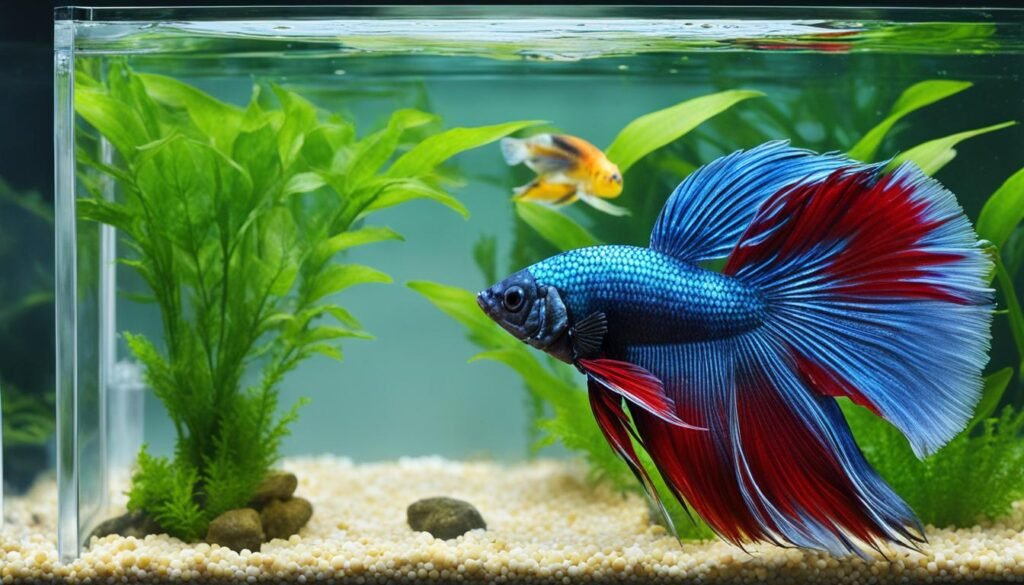Your cart is currently empty!

Uncover the Mystery: How Often Do Betta Fish Come Up For Air
Have you ever wondered how often betta fish come up for air? We’re here to shed some light on this fascinating behavior and provide you with all the information you need to understand your betta fish’s breathing habits.
Betta fish have a unique respiratory organ called the labyrinth organ, which enables them to breathe air directly above the water’s surface. This behavior is completely normal and not indicative of poor water quality. However, the frequency at which they come up for air can vary between individual fish.
Understanding your betta fish’s respiration rate and gill movement is crucial for their well-being. In this section, we will dive deeper into the mysteries of their oxygen intake and air breathing habits.
Key Takeaways:
- 1. Betta fish have a unique respiratory organ called the labyrinth organ that allows them to breathe air directly above the water’s surface.
- 2. Surfacing for air is a normal and natural behavior for betta fish, especially because they come from shallow, stagnant waters in their natural habitat.
- 3. The frequency at which betta fish come up for air can vary between individuals, but on average, they do so every few minutes.
- 4. It’s important to maintain a suitable tank environment with clean water, proper temperature, and enough space for the fish to swim and reach the surface easily.
- 5. Observing your betta fish’s behavior and monitoring any changes can help ensure their well-being and a comfortable living environment.
Is It Normal for Betta Fish to Go Up for Air?
When it comes to betta fish, their behavior of surfacing for air is completely normal and natural. These beautiful fish have a unique respiratory organ called the labyrinth organ, which allows them to breathe air directly from above the water’s surface. This behavior is a result of their adaptation to their natural habitat, which is often shallow and stagnant, with low oxygen levels. By surfacing for air, betta fish are supplementing their oxygen intake and ensuring their respiratory needs are met.
Understanding why betta fish go up for air is crucial for their proper care and well-being. It’s important to note that this behavior is not an indication of poor water quality or an unhealthy fish. However, sudden changes in their surfacing behavior should be monitored closely, as it could be a sign of a health issue or poor water conditions that need to be addressed.
While it is normal for betta fish to go up for air, the frequency at which they surface can vary between individuals. On average, bettas may come up for air every few minutes, although some may do so every 10-15 minutes, and others may surface more frequently. Each betta fish has its own unique style and preferences when it comes to surfacing for air. As long as they appear healthy and active, and their tank conditions are clean and well-maintained, their surfacing behavior is typically nothing to worry about.
How Often Do Betta Fish Come Up for Air?
When it comes to the frequency of betta fish surfacing for air, it can vary between individual fish. On average, bettas may come up for air every few minutes, although some may do so every 10-15 minutes, while others may surface more frequently. Each betta fish has its own style and preferences when it comes to obtaining oxygen.
It’s essential to understand that bettas have a unique respiratory organ called the labyrinth organ, which enables them to breathe air directly above the water’s surface. This behavior is completely normal and a natural adaptation to their native habitats, where oxygen levels may be low due to shallow, stagnant waters.
As long as your betta fish appears healthy and active, and the tank conditions are clean and well-maintained, their surfacing behavior is typically nothing to worry about. However, sudden changes in their surfacing frequency could indicate a health issue or poor water quality. Regularly monitoring their behavior and staying attentive to any changes will help ensure their well-being.
The Factors Influencing Betta Fish Surfacing Frequency
- Individual variation: Just like humans have different breathing rates, betta fish also have their own unique preferences when it comes to surfacing for air. Some may be more active and surface more frequently, while others may be more conservative.
- Water quality: Poor water quality can directly impact a betta fish’s surfacing behavior. If the water is dirty, contaminated, or lacking proper oxygen levels, your betta fish may surface more often to compensate for the inadequate conditions.
- Water temperature: Betta fish are tropical fish and thrive in warm water temperatures between 76-80 degrees Fahrenheit. If the water is too cold or too hot, it can affect their metabolism and lead to changes in their surfacing frequency.
- Stress levels: Stress can also influence a betta fish’s surfacing behavior. Factors such as overcrowded tank conditions, aggressive tank mates, or inadequate hiding spots can cause stress and potentially increase the frequency of their surfacing for air.
By providing a suitable tank environment with clean water, maintaining proper water temperature, and reducing stress triggers, you can help ensure that your betta fish has a comfortable and healthy habitat. Additionally, keeping an eye out for any changes in their behavior will allow you to address any potential issues promptly. Remember, each betta fish is unique, and understanding their individual needs is key to their overall well-being.
Tank Environment and Its Influence on Betta Breathing Frequency

Creating the perfect tank environment is essential for ensuring the well-being of your betta fish. The tank setup, size, water quality, temperature, and decorations all play a significant role in their breathing frequency. By providing a suitable habitat, you can help your betta fish thrive and exhibit their natural behaviors.
1. Tank setup and size:
When setting up a tank for your betta fish, it’s important to consider their natural habitat. Bettas are used to living in shallow, stagnant waters, so replicating this environment is ideal. A tank size of at least 5 gallons is recommended, as it allows enough space for the fish to swim and reach the surface for air without feeling cramped. Ensure that the tank has a secure lid to prevent any escapes and protect the fish from jumping out.
2. Water quality and temperature:
Betta fish are sensitive to poor water quality, so maintaining clean water is crucial. Perform regular water changes to remove any accumulated toxins and debris. Use a good filtration system to keep the water clean and free from harmful substances. Test the water regularly to monitor the levels of ammonia, nitrites, and nitrates. Additionally, bettas prefer warm water between 76-80 degrees Fahrenheit, so using a heater to maintain the appropriate temperature is essential.
3. Tank decorations:
Adding plants and decorations to the tank not only enhances its visual appeal but also contributes to the overall well-being of your betta fish. Live or silk plants provide hiding spots and resting places for the fish, reducing stress and promoting a sense of security. Avoid plastic plants with sharp edges that may damage their delicate fins. You can also consider adding caves, driftwood, or other structures that create interesting and varied environments for your betta fish to explore.
By paying attention to the tank environment and making necessary adjustments, you can provide your betta fish with a comfortable and stimulating habitat. Remember to monitor their behavior and ensure that they have clean, well-maintained water and appropriate conditions for them to thrive.
Conclusion
After exploring the fascinating world of betta fish, we can conclude that their surfacing behavior is completely normal and a natural part of their biology. Bettas have a unique respiratory organ called the labyrinth organ, which allows them to breathe air directly above the water’s surface. This behavior is their way of supplementing their oxygen intake, especially in their natural habitat where oxygen levels may be low.
The frequency of betta fish surfacing for air can vary between individuals. On average, they may come up for air every few minutes, while some may do so every 10-15 minutes, and others may surface more frequently. Each betta fish has its own style and preferences, so as long as they appear healthy and active, and their tank conditions are clean and well-maintained, their surfacing behavior is typically nothing to worry about.
Creating a suitable tank environment is crucial for the well-being of betta fish. It’s important to provide clean water with suitable parameters, maintain the right temperature between 76-80 degrees Fahrenheit, and ensure they have enough space to swim and reach the surface for air easily. Regular water changes, a good filtration system, and testing kits are essential for maintaining water quality. Adding plants or decorations to the tank can also provide hiding spots and reduce stress-induced air-gulping.
We hope this article has provided valuable insights into betta fish breathing habits. By understanding their unique respiratory system and providing them with a comfortable and healthy environment, we can ensure their well-being and enjoy watching their fascinating surface-skimming habits.
FAQ
How often do betta fish come up for air?
Betta fish may come up for air every few minutes, but the frequency can vary between individual fish.
Is it normal for betta fish to go up for air?
Yes, it is completely normal for betta fish to surface for air. They have a unique respiratory organ called the labyrinth organ, which allows them to breathe air.
How does the tank environment influence betta fish breathing frequency?
The tank environment plays a significant role in a betta fish’s breathing frequency. Providing clean water, proper temperature, and enough space is crucial for their well-being.
What should I do to maintain suitable tank conditions?
Regular water changes, a good filtration system, and testing kits are essential for maintaining water quality. Betta fish prefer warm water between 76-80 degrees Fahrenheit, and a heater can help maintain the right temperature. The tank size should be adequate, allowing the fish enough space to swim and easily reach the surface for air. Adding plants or decorations can provide hiding spots and reduce stress-induced air-gulping.
Why is it important to monitor betta fish behavior?
Monitoring betta fish behavior and any changes can help ensure they are living in a comfortable and healthy environment. Sudden changes in behavior could be a sign of a health issue or poor water quality.
Leave a Reply